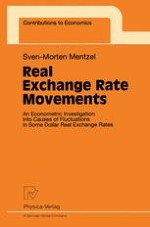One aim of this book is to examine the causes of fluctuations in the mark/dollar, pound/dollar, and yen/dollar real exchange rates for the period 1972-1994 with quarterly data to determine appropriate policy recommendations to reduce these movements. A second aim is to investigate whether the three real exchange rates are covariance-stationary or not and to which extent they are covariance-stationary, respectively. These aims are reached by using a two-country overshooting model for real exchange rates with real government expenditure and by applying Johansen's maximum likelihood cointegration procedure and a factor model of Gonzalo and Granger to this model.
